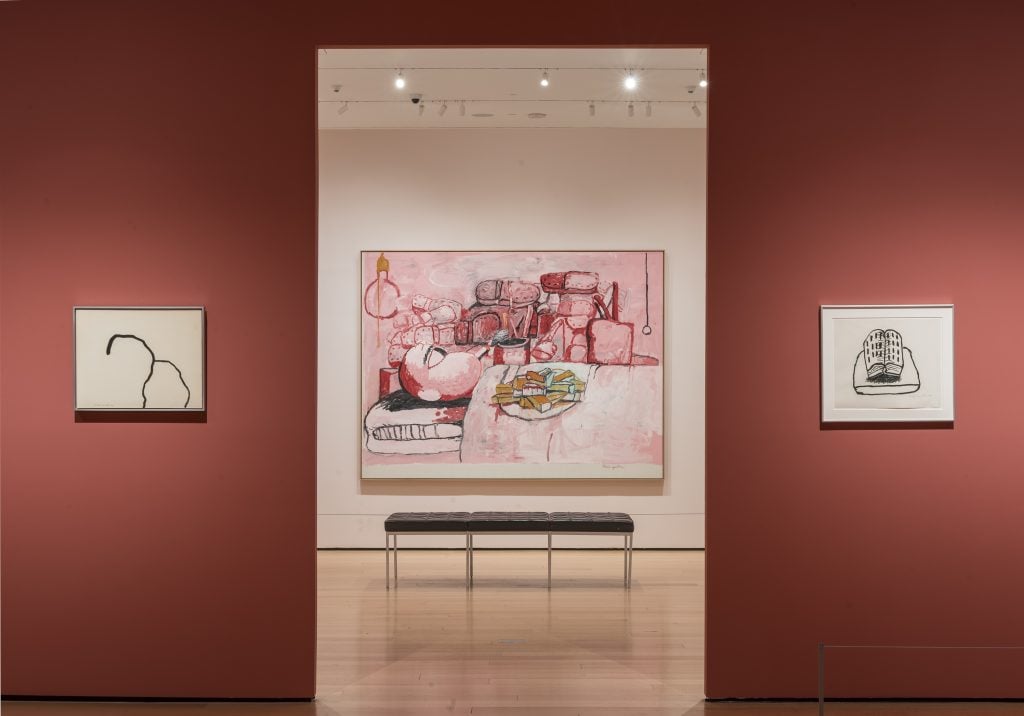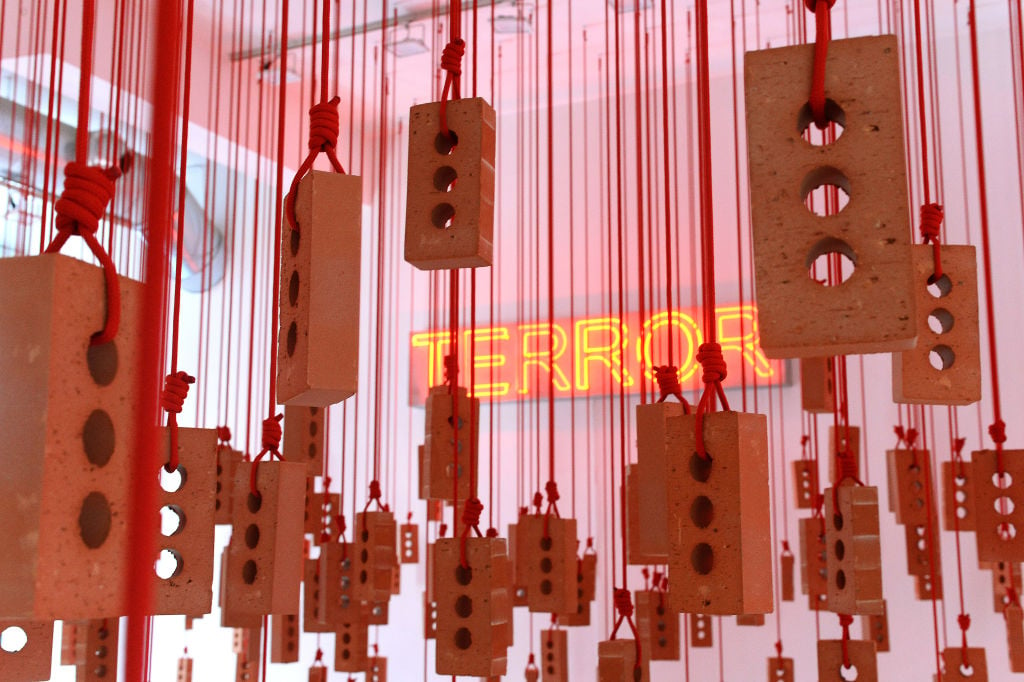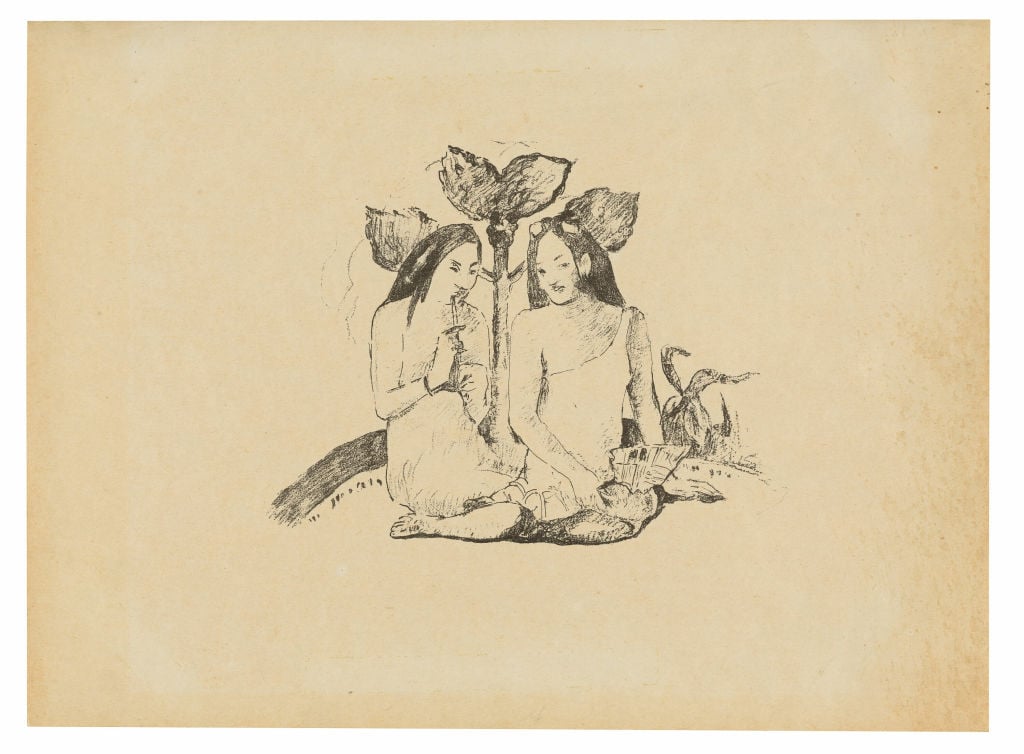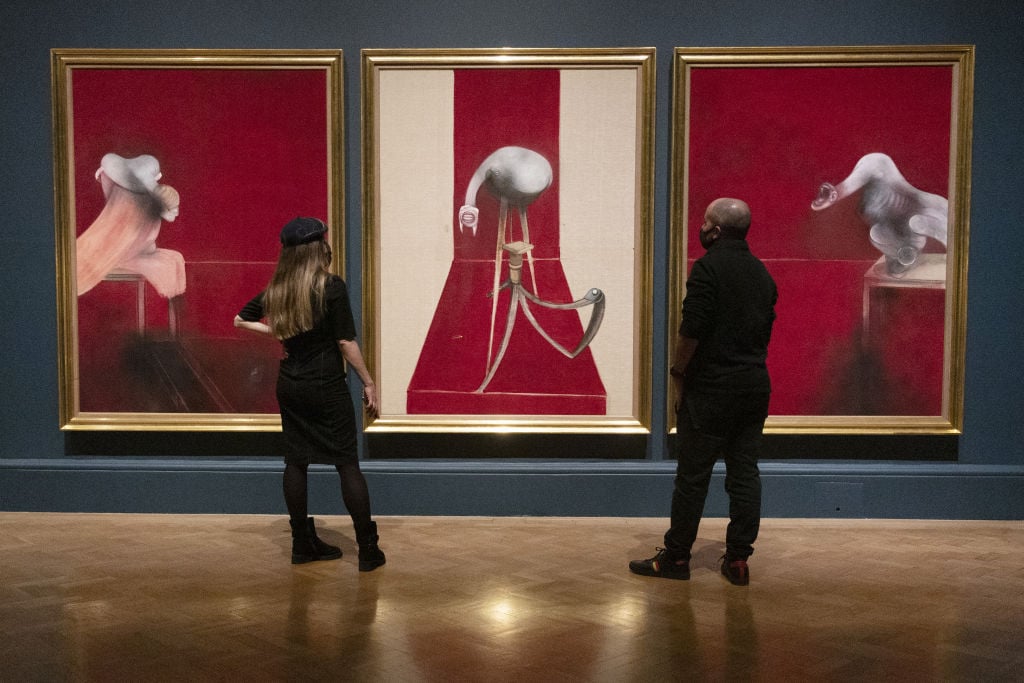Opinion
Warning Labels at Museums Make Art More Accessible to All—But They Should Stop Short of Telling Us How to Think
How taking my child to a provocative museum exhibition made me reconsider the value of warning labels.

How taking my child to a provocative museum exhibition made me reconsider the value of warning labels.

Hettie Judah

As a younger mother I visited SMAK—a museum in the Belgian city of Ghent—with my little sons. SMAK was hosting a survey by the South African artist Kendell Geers. I did not know his work, and asked whether it was OK to visit with children. Sure, they said. No further comment.
The first space was lined with body bags. It’s fine, I thought. Kids only see what they know to look for! Well, maybe, not always. We whizzed through another gallery wallpapered with imagery appropriated from porn magazines. My oldest had just learned to read and diligently sounded out a word Geers uses in his neons and wallpaper works: “f-u-c-k-i-n….”
In the upper galleries, I negotiated unruly boys around floor-standing sculptures made from razor wire and broken glass.
Do I regret taking my kids to the show? We emerged intact (albeit one of us with enriched vocabulary) so, on balance, no harm done. Do I think SMAK should have modified the show to accommodate my children? Absolutely not. Had there been a content warning alerting me to the nature of the work, might I have chosen a different show? Yes.

View of Kendell Geers’s “OrnAmenTum’EtKriMen” exhibition at M77 Gellery on February 18, 2021 in Milan Photo by Roberto Serra – Iguana Press/Getty Images.
I share this anecdote not just so that you can delight in my poor parenting, but because, as arguments flare around content warnings and exhibition signage in art galleries, it offers a few pointers that might help us negotiate this contested territory.
The first is the question of prior knowledge. In the art world there is an unpleasant tendency to speak from a position of knowledge and to treat those who do not share it high-handedly. After spending years studying, say, Philip Guston, Francis Bacon, or Louise Bourgeois, it might seem to us ludicrous to apply content warnings to their work. But for some gallery visitors the current show may be their first encounter with the work, and it may well be surprising (or even shocking) to them.
Art and its audiences are in a constant state of churn. Not only is there always a new generation coming, but the context within which we view older art also shifts. Let us not dismiss those approaching our pet subject with fresh eyes.
To offer a content warning on an exhibition or artwork is not to delegitimize its place in the institution. If anything, it is an acknowledgment of that work’s power (intended or otherwise). Works that engage with death, birth, violence, trauma, bigotry, drug use, exploitation, and sexuality are vital, but we don’t always have the energy or will to engage with them. Rather than removing a work of art from public view, a content warning offers a choice. It allows us to say “Not for me. Not today,” rather than “Not for anyone. Not ever.”

Paul Gauguin, Two Maori Women Squatting Down (1894/95), published Feb. 3, 1895. Photo by Heritage Art/Heritage Images via Getty Images.
A content warning is also part of the framing voice of the institution: It offers a context that anticipates a variety of human responses, all of them valid. This sounds like a trivial point, but I think it nonetheless important. We are schooled to respect authority figures and to believe they act in our best interests. We may later find this belief laughable, but ghosts of this messaging can still haunt us. If a museum (as an authority figure) is inviting us to look at something that we feel in our gut to be horrible and wrong, it can help that a framework is in place suggesting the institution anticipates or is willing to engage with this response.
Such messaging is not always received in the intended spirit. Too often in the conservative press it is confused and (perhaps wilfully) misread as a prelude to censorship.
New York Times journalist Farah Nayeri’s recent book on art, power and censorship, Takedown, grew out of a feature she wrote on Paul Gauguin. Published under the headline “Is It Time Gauguin Got Cancelled?” The story explored how, in the post-MeToo era, curators responded to the French artist’s sexual relations with underage girls in Tahiti. An exhibition of Gauguin’s portraits at London’s National Gallery greeted visitors with text explaining that the artist “undoubtedly exploited his position as a privileged Westerner to make the most of the sexual freedoms available to him.”
Nayeri reported that the new curatorial consensus was:“Gauguin should certainly be shown, but with his private life revealed rather than swept under the carpet.” Part of the curatorial strategy around Gauguin was that audiences stepped into the exhibition forewarned.
Nayeri’s article sparked outrage in France, where, she explains, “such debates are viewed as manifestations of political correctness gone awry.” Visiting the Musée d’Orsay after the storm had passed, she wondered whether her feelings about Gauguin might have changed:. Instead she found his work “sensational,” she wrote. “No part of me was condemning of what I saw on the canvas. I had never asked for Gauguin to be taken down, and I found myself just as eager to see more of his work in the future.”

Second Version Of Triptych in “Francis Bacon: Man and Beast” at the Royal Academy in London. Photo by Ray Tang/Anadolu Agency via Getty Images.
Often the manufactured outrage around content warnings betrays more about the complainant than the institution. “Francis Bacon: Man and Beast” at London’s Royal Academy earlier this year included a warning that the exhibition “contains adult content.” What constitutes adult content? With Bacon, take your pick: suicide, alcoholism, bull-fighting, existential torment, the whole bundled horror of human existence. The arena in which he performed was awash with dread and brutality. Nevertheless, the right-wing Daily Telegraph responded with clickbait fodder insinuating that “adult content” referred specifically to nudity.
The literature and choreography currently framing the show “Philip Guston Now” at the MFA Boston is a case apart. Equipping visitors with an “Emotional Preparedness” statement ahead of the exhibition—which contains various works for which Guston confronted social wickedness and bigotry by searching for traces of evil inside himself—the institution here extends its role, re-casting itself as provider of both harm and care, trauma and salve.
We seem to have found ourselves at a moment where art is positioned on an axis of extremes. At one end, the gallery is proposed as a place of healing (“Can art rebalance your chakras?” asked one recent press release). At the other, art, such as Guston’s klansmen paintings, are imagined as a source of trauma, rather than an engagement with it.
In her book On Freedom, Maggie Nelson wrote: “Suggesting that certain pieces of art should be treated as acts of violence… plays into the same arguments that have long been used to undermine art’s legal protections.”
Toddlers and razor wire aside, we should be wary of over-egging art’s capacity to harm. A content warning is an invitation to make a choice—a precursor to an informed engagement with art. In introducing an exhibition by anticipating art’s capacity to hurt, exhibition texts risk deadening our free interpretation and engagement with work rather than enriching it.